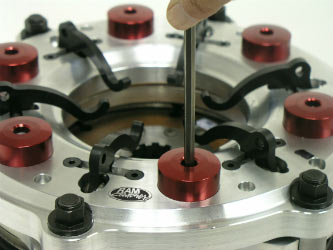How to Become an Indispensable Clutch Man
 The crew chief keeps track of two critical adjustments (among other things) to these clutch assemblies when setting up the car. The base pressure (static) is a fixed, constant pressure on the clutch springs. This adjustment is made with the Allen-head screw on top of each individual spring. |
It’s no secret that the modern day racing clutch has morphed into a pretty significant piece of engineering. Of course, all that became possible thanks to evolution. In short, constant increases in horsepower, ongoing trends in tire technology, nitrous oxide developments, better superchargers, and that all-important “need for speed” are responsible for wholesale changes in clutch design and application. Single-disc street-type clutches gave way to multiple-disc units, while at the same time clutch facing (or friction) materials went through a whole series of upgrades and changes over the years. You know the story – nothing stays the same in life. We thought it would be interesting to shed some light on just how these clutches operate in the intense arena of ADRL competition – namely, in the highly competitive world of Pro Nitrous and Extreme Pro Stock. In order to do that, we contacted the pros at Ram Clutches, based in Columbia, South Carolina., which seems to be the clutch of choice for many of today’s top racers. Intriguingly, most of these eighth-mile ADRL Pro Stock cars also compete in the MMPSA (Mountain Motor Pro Stock Association) championship, which run twice the distance with little or no changes to their specifications. Similarly eighth-mile ADRL Pro Nitrous cars regularly compete in quarter-mile NHRA Pro Mod events.


